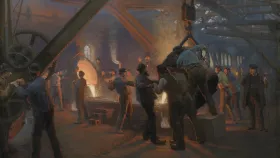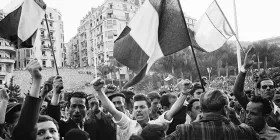Essential Events Between 1900 and 1945
Learn how two world wars and other critical developments reshaped global affairs in the first half of the twentieth century.
Teaching Resources—World at War: Introduction & U.S. As a Global Power (including lesson plan with slides)
Higher Education Discussion Guide
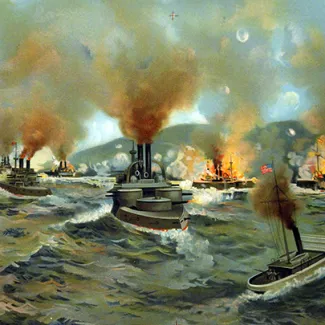
Library of Congress
On February 15th, 1898, the USS Maine exploded in Cuban waters. 266 Americans on board the vessel were killed, leaving the nation reeling and eager to find the perpetrator. Following the explosion, sensational news reports blamed Spain. After riling up public support, the United States declared war on Spain, entering Cuba’s war for independence from its Spanish colonizers. But what then-U.S. Secretary of State John Hay, referred to as a “splendid little war” was more than just a major power struggle over interests in the Americas. Rather, the conflict clearly signaled the United States’ growing ambitions on the world stage and, in this case, closer to home. Nearly three hundred thousand Americans, including Theodore Roosevelt’s Rough Riders, answered President William McKinley’s call for troops. After months of fighting, Cuba emerged with its independence, and the United States emerged with much of Spain’s colonial empire in the Caribbean and Pacific. Following the Spanish-American War, the U.S. claimed control of Guam, the Philippines, and Puerto Rico. Additionally, the Platt Amendment, which the United States insisted be part of the Cuban constitution, designated Guantanamo Bay as a permanent U.S. military base. A country whose sovereignty once failed to span its own mainland now controlled territories across the globe
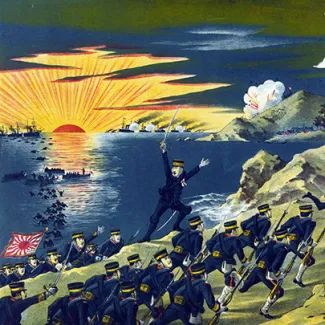
Universal Images Group via Getty Images
The breakout of the Russo-Japanese War in 1904 capped a decades-long tussle between Japan and Russia over the resource-rich region of Manchuria. Japan emerged victorious, proving its capacity to trump Western military might—a rarity in the nineteenth century. This milestone helped cement Japan’s reputation as a growing military and colonial power, one to be treated as an equal—diplomatically—by Western powers. The failed military campaign weakened the prestige of czarist Russia, dampening imperial ambitions in East Asia and nearly leading to revolution at home. By the conflict’s close, Japan controlled much of southern Manchuria and the region’s valuable mining and railroad interests; by 1910, the island nation had fulfilled further imperial ambitions by annexing Korea.
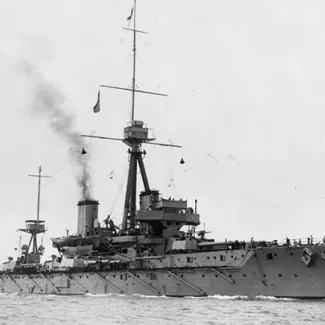
Imperial War Museums
The late nineteenth and early twentieth centuries were periods of rapid technological innovation. The automobile, radio, and television—invented in 1886, 1901, and 1927 respectively—would all go on to change the course of history. But it was the launch of the British warship HMS Dreadnought that sparked the first arms race of the twentieth century. The ship, a feat of naval engineering, featured twelve-inch guns, submerged torpedo tubes, and steam turbine engines, which had never been brought together before. The following arms race on land produced long-range weapons, chemical gas, and difficult-to-reverse military mobilizations. This frenzied militarization among the world’s most powerful countries contributed to the inevitability of World War I.
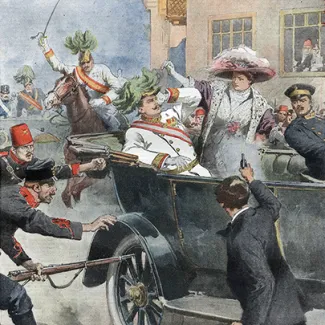
Achille Beltrame/Domenica del Corriere
On June 28, 1914, Archduke Franz Ferdinand, heir to the throne of Austria-Hungary, was assassinated. The murder of Franz Ferdinand caused tensions to boil over in Europe, leading to the start of World War I. But why did the assassination of one man cause the whole world to dive into conflict? The short version: it’s complicated. The longer version requires looking at the long-term forces that led to mutual hostility and suspicion among European powers. These forces include: fervent nationalism, imperial competition for new markets, an arms race, mobilization plans, and values such as militarism. Additionally, alliance systems, meant to act as a deterrent to conflict, dragged their members into war. These forces produced a conflict that would turn what most thought would be a quick “home by the holidays” skirmish into a deadly four-year military engagement. The so-called “Great War” was a continent-spanning conflict between the Central Powers (Austria-Hungary, Germany, and the Ottoman Empire) and the Allied Powers (Britain, France, Russia, and eventually Italy and the United States). Other countries such as China and Japan were also involved in the fighting. Ultimately, World War I killed approximately nine million soldiers, which at the time was the deadliest war in European history.
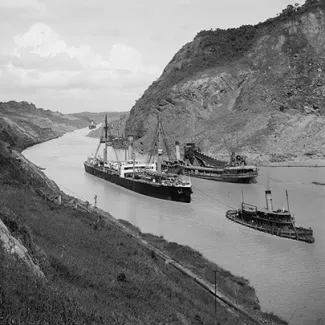
Library of Congress
After gold was discovered in California in 1848, Americans were desperate for a faster way to get from coast to coast. This desire only increased when Hawaii and the Philippines became U.S. territories; empire-building highlighted the need for a shortcut between the Atlantic and Pacific Oceans. To accommodate their imperial ambitions, the United States needed a route that would allow warships and commercial vessels to get from one U.S. coast to another without rounding South America. By encouraging and supporting Panama’s push for independence from Colombia, the United States ultimately succeeded in building the Panama Canal. The waterway officially opened to traffic in 1914. The United States could now sail far more easily and safely between its two shores. This man-made feat allowed the country to integrate its domestic economy and continue on its path toward becoming a global superpower.
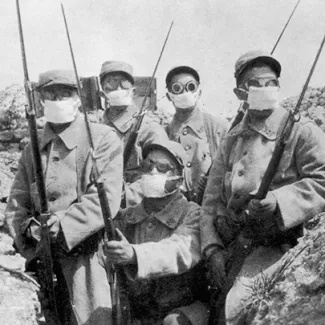
Hulton Archive via Getty Images
From the use of tanks and submarines, to the widespread deployment of fighter pilots and new military uniforms with steel helmets, World War I was truly a conflict of military firsts. Sadly, this also marked the first time chemical weapons and machine guns were used on such a massive scale. Throughout the war, the machine gun resulted in massive casualties. Soldiers could shoot rapidly and continuously to great effect without even aiming at a specific target. During the Second Battle of Ypres, the German army opened thousands of cylinders of chlorine gas in the trenches along its defensive perimeter in Belgium. The results were immediate. A wall of gas killed more than six thousand Algerian and French soldiers and harmed thousands more. The war marked the first time in modern warfare that an army used weapons of mass destruction. This fateful milestone would be repeated during World War I and in future conflicts, inspiring international backlash and the ultimate emergence of the Chemical Weapons Convention in 1993.
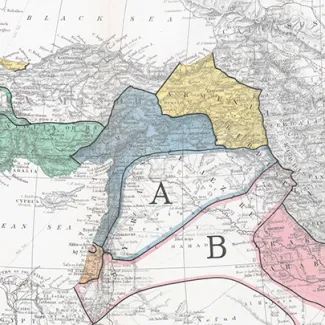
British Library
Anticipating a victory, two senior diplomats—Britain’s Sir Mark Sykes and France’s Francois Georges Picot—met in secret at the height of World War I to plan ahead for the changing world order. Sykes and Picot agreed to preemptively divide up the fallen Ottoman Empire into their respective spheres of influence. This territory included present-day Turkey and most of the Arab Middle East. When Bolshevik Russia leaked news of the meeting, outrage ensued due to Britain’s clear intention to withdraw its promised support for an independent Arab kingdom. Despite the leak, the terms of the Sykes-Picot Agreement, which eventually included Italy and Russia, were mostly codified by the Treaty of Sèvres. Both Britain and France went on to draw new borders that had less to do with the people living in those areas and more to do with imperial ambition. In fact, the victors of World War I had designs to fuel their empires: European access to oil and Mediterranean seaports held supremacy over respect for Middle Eastern sovereignty.
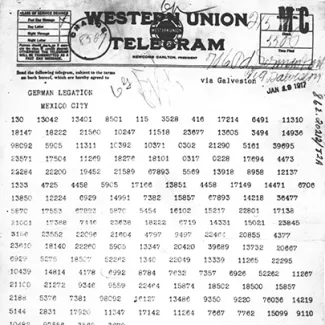
U.S. National Archives
Despite its growing global power, the United States sought to stay out of World War I. Its resolve was tested in 1915 when German submarines attacked a British ocean liner, the RMS Lusitania. The assault killed nearly 1,200 people, including over 100 Americans. In a bid to maintain American neutrality and respond to public condemnation, Germany agreed to cease its submarine activity against civilian shipping. However, in 1917, Britain intercepted a note sent by Germany to Mexico proposing a military alliance and promising to help Mexico reclaim lost territory from the Mexican-American War. The Zimmerman Telegram, coupled with Germany's decision to resume unrestricted submarine warfare in 1917, led a reluctant United States into the war. By July 1918, one million American troops had arrived in Europe to fight with the Allied forces; by November, Germany was fatally weakened and the war was over.
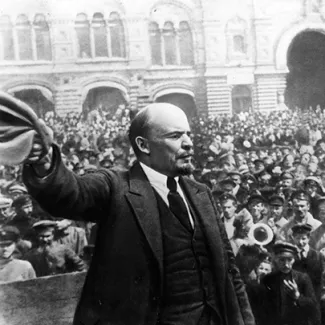
Keystone via Getty Images
After sustaining territorial losses in the early twentieth century and devastating loss of life during World War I, the czarist regime in Russia was on the verge of collapse. In early 1917, protests led by working-class women, and joined by factory workers and deserted soldiers, escalated into a revolution. By the end of that year, revolutionaries overthrew Tsar Nicholas II and established a provisional democratic government in the country. This kicked off a period of seismic change within Russia. Democracy was short-lived, as Vladimir Lenin led a faction of Communists–known as Bolsheviks–to overturn the just-installed government. Upon his ascension to power, Lenin created the Cheka, or secret police. This law enforcement network had the authority to execute those who didn’t comply with the government's new rules. Among the most controversial was the nationalization of private land and factories. By 1918, civil war had engulfed the country. Civil conflict forced Russia to withdraw its forces from World War I as Lenin hoped to stabilize the country and consolidate his power; five years later, Bolsheviks, now known as the Communist Party of the newly formed Soviet Union, defeated the so-called “Whites.” Lenin emerged from the civil conflict as the undisputed leader of the Soviet Union, controlling most of the former Russian Empire.
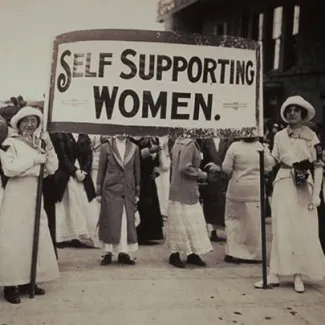
Schlesinger Library
Before the turn of the twentieth century, only one country—New Zealand—gave women the right to vote. It wasn’t until World War I that meaningful strides were made toward granting women suffrage around the world. The global scale of conflict made it necessary for women to enter the workforce.This shift highlighted a glaring injustice: that women could work and die for the war, yet they could not vote for it. In 1906, Finnish women were the first Europeans to win the right to vote. Norway (1913), Russia (1917), Britain (1918), Canada (1918), and Germany (1918) followed by granting women suffrage in short order. However, British women could not vote until the age of thirty and some Canadian women could not vote based on their race. In the United States, the passage of the Nineteenth Amendment in 1920 gave women the right to vote. However, universal suffrage was restricted due to the presence of racist laws intended to thwart political participation in Black communities. Jim Crow legislation, designed to suppress people of color, would remain in place for decades to come.
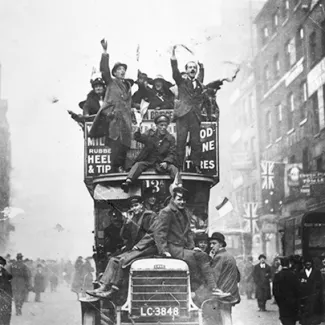
Topical Press Agency via Getty Images
At 11 a.m. on the eleventh day of the eleventh month of 1918, World War I came to a halt. Ona day now known as Armistice Day the Allies emerged victorious. However, the winner of World War I had little to celebrate. During four years of war, over ten million civilians and roughly nine million soldiers died. In addition to the shocking death toll, more than twenty million people were left wounded, some injured for life. In the conflict’s final year, a deadly virus later known as the Spanish Flu coursed through the world. This pandemic ultimately infected about one-third of the planet and took upwards of fifty million lives. World War I was unprecedented in many ways, but particularly in the death, carnage, and environmental destruction it caused. Known at the time as the war to end all wars, World War I proved to be the opposite. The culmination of the first world war planted the seeds for another devastating conflict just two decades later.
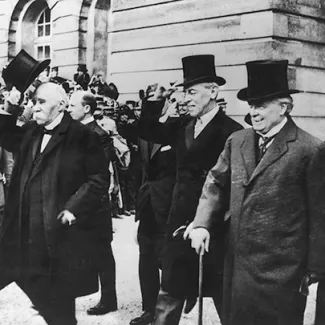
Hulton Archive via Getty Images
Two months after World War I ended, world leaders convened in Paris to discuss the terms of peace. The war’s victors—led by the United States, Britain, and France—dominated conversations over peace terms. Multiple treaties emerged, most notably the Treaty of Versailles. This treaty forced major territorial concessions from Germany and limited its army and navy. Most consequentially, it forced Germany to accept responsibility for the war and to pay reparations for damages done to its enemies. The punitive terms of peace infuriated the German people, which fueled the rise of Adolf Hitler in the coming years. The Treaty of Versailles also established the League of Nations to serve as an international forum to promote collective security and avoid renewed conflict. The organization’s effectiveness, however, was limited by several factors, including the United States’ ultimate refusal to join.
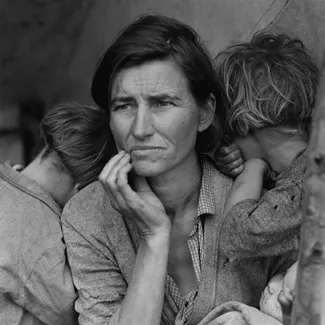
Library of Congress
Before World War I, the global economy was booming. Technological advances (such as the steamship and the telegraph) coupled with trade and investment sparked an era of economic growth. Meanwhile, the relatively free movement of people without immigration limits—or passports—brought the world closer together than ever before. The postwar world, however, was a different story: countries grew protectionist, and trade and immigration restrictions followed. When the U.S. stock market crashed on October 29, 1929, the Great Depression was already starting to affect countries around the globe. The depression spread to Europe by 1931, pushing many governments toward authoritarian regimes. In Germany, the country’s economy tanked and unemployment soared. Germans were drawn toward radical anti-democratic parties on both the right (Nazis and nationalists) and the left (Communists) which promised solutions. Adolf Hitler would mix this economic desperation with his racist, toxic nationalism. This virulent, yet effective, political cocktail allowed Hitler to gain and consolidate power. Ultimately, Hitler and his Nazi Party would lead the world into a war more deadly than the first.
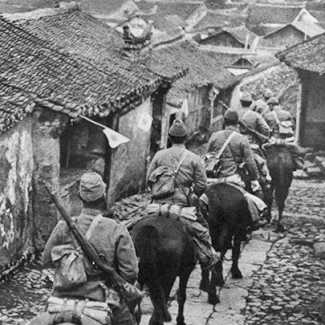
Corbis via Getty Images
The worldwide embrace of post-war protectionism had a ruinous effect on global trade. Rapidly changing economic conditions put the island nation of Japan in a particular bind. Motivated by the need for food, raw materials and new markets, the Japanese invaded Manchuria. This military campaign marked the start of Japan’s aggressive expansion campaign across East Asia and the Pacific. Though the Japanese promoted the invasion as “independence” for Manchuria, the League of Nations rejected this view and urged Japan to withdraw from the region; it withdrew from the League instead. After Japan went on to invade further parts of China in 1937, war crimes became common. One of the most horrific instances was the Rape of Nanjing, where between one hundred and three hundred thousand people were killed. In addition to the rapid killings of Chinese nationals, between twenty and eighty thousand women were sexually assaulted.
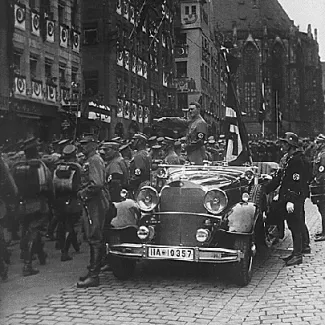
U.S. National Archives
By 1932, almost 25% of Germany’s twenty-five million person workforce were unemployed. The Great Depression caused severe economic pain for many Germans, creating fertile ground for the ideas of Adolf Hitler. Hitler’s Nazi Party appealed to the masses by promising to fix Germany’s broken economic system and make Germany a great power again. To gain electoral support, the party initially downplayed Hitler’s extreme views on race and exploited people’s fears of communism. In 1933, Hitler was named chancellor of Germany by conservatives in the parliament who thought they could use him politically. However, Hitler almost immediately passed legislation allowing himself to centralize power in Germany's government. By 1934, he had become the supreme leader of the country. Shortly thereafter, Hitler eliminated all other political parties and passed the Nuremberg Laws ending civil liberties for Jewish people in Germany. Hitler also began to build up the country’s military, clearly violating the Treaty of Versailles. Hitler’s campaign of European expansion and aggression was officially underway.
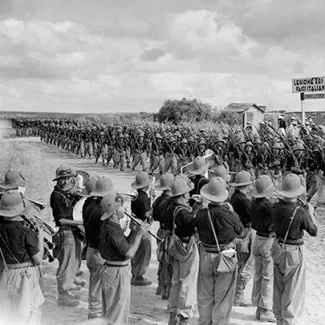
Mondadori via Getty Images
For decades, Ethiopia remained independent while European powers colonized its neighbors. To legitimize its own sovereignty, Ethiopia joined the League of Nations in 1923. However, in 1935, an emboldened Italy led by fascist dictator Benito Mussolini invaded Ethiopia. The League protested the invasion, but took little action; world leaders even declined to close the Suez Canal to Italian ships. Moreover, Italy’s usage of mustard gas against both Ethiopian military forces and civilians did little to change the League's hands-off approach. Once again, the ineffectiveness of the League of Nations was on display. By 1936, Italy had annexed Ethiopia and merged the country with Eritrea and Somaliland into a single country known as Italian East Africa. Mussolini then signed on to the Rome-Berlin Axis, formalizing cooperation with Hitler; in 1939, this relationship was strengthened by the signing of the Pact of Steel. This pact formalized a full military alliance between Fascist Italy and Nazi Germany.
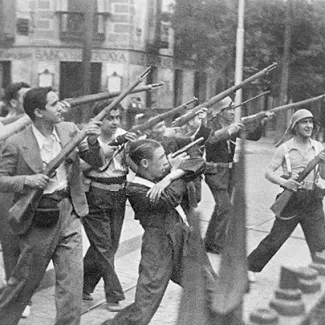
AFP via Getty Images
As authoritarian or far-right governments came to power across Europe, Spain was ripe for civil conflict. In July of 1936, a coup in Spain pitted the country’s liberal and leftist Republican government against the Nationalists. The Nationalists were a group of fascist rebels led by General Francisco Franco who were eager to overthrow the Spanish Second Republic. Britain and France declined to get involved in the resulting civil war, although the Soviet Union supported the Republicans. Franco turned to Germany and Italy for aid, and Italy supplied seventy-five thousand troops, plus pilots and planes. Meanwhile, Germany used the conflict to test-run blitzkrieg, or lightning war. This military strategy was designed to overwhelm its opponents with coordinated attacks by air and on the ground. Thousands of foreign fighters traveled to Spain to fight against the advance of fascism. However, after three years of bloodshed, the fascists emerged victorious and Franco established himself as dictator. Though Spain did not join the Axis powers (Germany, Italy, and Japan) in World War II, many historians consider the Spanish Civil War as a practice for the impending global conflict.
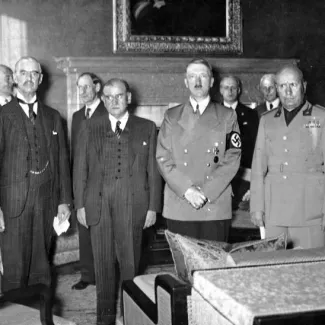
German Federal Archives
In the years leading up to World War II, Nazi Germany grew more aggressive both inside and outside its borders. At home, Hitler institutionalized and escalated violence against minority populations. Abroad, Germany annexed Austria, declaring their intentions for rapid territorial expansion. However, Hitler drew little response from European leaders, who instead tried to accommodate or appease him. European leaders believed that a policy of appeasement was necessary to avoid another devastating global conflict. In 1938, leaders of Britain, France, Germany, and Italy met in Munich to discuss Germany’s desire to annex the Sudetenland, an ethnically-German region in the newly formed country of Czechoslovakia. During these meetings, Britain and France—once again—declined to stop Germany’s growing aggression. By August 1939, Germany had entered into a nonaggression pact with the Soviet Union. This agreement allowed the Nazis and Soviets to divide up spheres of influence in Eastern Europe and pave the way for the two countries to invade Poland, which took place weeks later. World War II was in full swing.
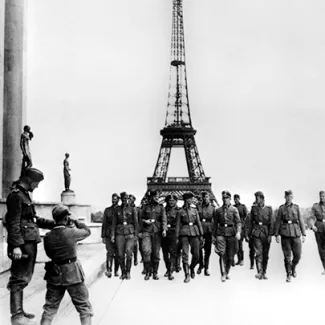
Universal Images Group via Getty Images
By the beginning of 1940, much of Eastern Europe was occupied by Nazi Germany and the Soviet Union (the Soviet Union had also invaded Poland and annexed and occupied land in Eastern Europe). Hitler then set his sights west, invading France through Belgium. The Germans overwhelmed the French in just six weeks. After Paris surrendered, the Nazis divided the conquered country in half. Hitler’s army occupied the north and set up a puppet government in the city of Vichy to rule the south. As Germany set its sights on an invasion of their island nation, British air forces emerged successful from the so-called Battle of Britain. Victory in this battle prevented the Germans from dominating the air over Britain and its coastal seas; German air supremacy would have enabled Hitler to carry out his invasion. Undeterred, Hitler began a bombing campaign known as the Blitz, in which British cities were attacked every night for eight months. During the Blitz, British citizens lived in terror. Many sheltered underground at night, only emerging in the day to survey the damage done and care for the wounded and dead. The Blitz campaign ended in May 1941, as stiff British resistance persuaded Hitler to divert his attention to an old friend turned foe. Hitler turned his military against the Soviet Union, which he believed had become a greater threat to his ambitions.
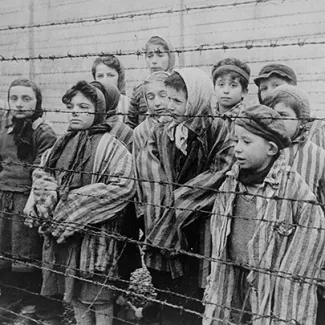
U.S. Holocaust Memorial Museum
As Nazi Germany invaded and overtook much of Eastern Europe, it forced Jewish people into ghettos with terrible living conditions. This repression escalated into organized violence on November 9, 1938—known as the Night of Broken Glass, or Kristallnacht. On this night, Nazi soldiers set fire to synagogues, schools and homes, and sent thirty thousand Jewish people to concentration camps. By late 1941, Nazis were implementing a system Hitler referred to as the “final solution to the Jewish problem.” As a result of the “final solution,” Jewish people from across Europe were gathered and sent to killing centers designed specifically for mass murder. Over the course of the war, thousands of German citizens and foreign collaborators aided the Nazis as they murdered six million Jews and millions of other persecuted people. After the war, the term genocide—the deliberate harming of a specific group of people—emerged as a key component of human rights law to describe this atrocity, which was known as the Holocaust.
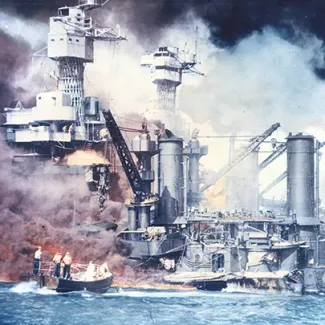
U.S. National Archives
As fighting raged in Europe and Asia, U.S. lawmakers remained determined to stay out of World War II. In reality, though, the United States’ Lend-Lease policy, which ultimately distributed more than $45 billion in military supplies to its European and Asian friends, put the United States increasingly on the side of the democratic, anti-Fascist allies. Meanwhile, U.S. embargoes made Japan increasingly desperate for oil and other essential war materials. Economic strangulation led to Japan’s provocative decision to occupy French Indochina, neighbor to the U.S.-controlled Philippines. As last-ditch negotiations to end the embargoes faltered, Japan launched a surprise attack on a U.S. major military base in Hawaii. This attack killed more than two thousand U.S. soldiers, sank four U.S. battleships, and destroyed hundreds of aircraft. Referring to the December 7, 1941, attack on Pearl Harbor as “a date which will live in infamy,” President Franklin D. Roosevelt asked Congress for a declaration of war against Japan. Following a nearly unanimous vote in Congress, war was declared the following day; three days later, Japan’s European allies declared war on the United States. Once again, the United States found itself entrenched in another global conflict.
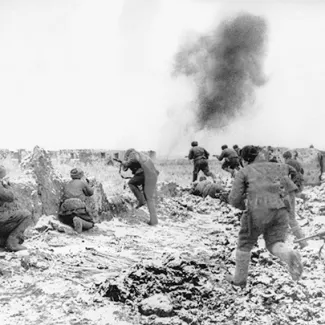
DPA/Picture Alliance via Getty Images
In June 1941, Nazi Germany launched the largest-scale military attack in modern history. Hitler deployed three million soldiers against the Soviet Union, violating the nonaggression pact signed between the two countries in 1939. In early victories, Germany conquered large swathes of territory. Within five months, the Nazis took over half a million prisoners of war. But then the brutal Russian winter arrived. German machines froze and fighting slowed. When it resumed in earnest the following spring, Germans attacked Stalingrad. The goal: to seize Soviet oil fields to the south. In a battle considered the war’s turning point, the city survived Germany’s onslaught. The Soviet Union then launched a successful counteroffensive following Stalingrad’s defense. The resulting victory was not without losses: approximately two million people perished during this half-year battle. More Soviet soldiers died in this one siege than American soldiers throughout the whole war; only six percent of the captured German soldiers survived. The beginning of the end of World War II had arrived.
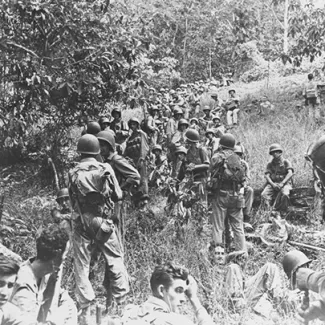
Naval History and Heritage Command
Within hours of their assault on Pearl Harbor, Japanese forces attacked several Pacific countries and territories. Their targets included Hong Kong, Indonesia/the Dutch East Indies, Malaysia, Singapore, and the U.S. territories of Guam and the Philippines. After roughly half a year of Japanese momentum, the United States destroyed several of Japan’s aircraft carriers at the Battle of Midway in June 1942. Following this victory, the United States went on the offensive, setting its sights on Japanese-controlled Burma, Guadalcanal in the Solomon Islands, and the rest of the Pacific. At the Battle of Guadalcanal, Japan lost two-thirds of its soldiers during a six-month battle it ultimately lost. Following a string of victories, the United States began a campaign of strategic island-hopping toward the Japanese archipelago in 1943. Meanwhile, Japan’s Axis allies had recently faced significant losses in Northern Africa. The British scored key victories, breaking through German and Italian military lines threatening Egypt and the Suez Canal. Allied forces also gained a key victory in El Alamein, Egypt. As the Allies gained ground in the Pacific and Northern Africa, the tide of the war began to turn in their favor.
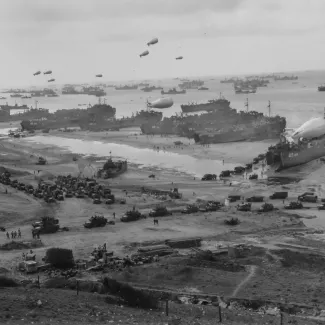
U.S. National Archives
After gains in Eastern Europe, Northern Africa, and the Pacific, the Allied forces sought to relieve pressure on the Soviet Union’s forces by attacking Germany from the South and West. In July 1943, the Allies invaded Sicily which signaled the start of the successful Italian campaign and the downfall of Benito Mussolini. After Mussolini was overthrown, the new government signed an armistice that left Germany isolated. Then, in an effort to liberate France, the Allies stormed the beaches at Normandy. Augmented by overnight parachute and glider landings, massive air attacks, and naval bombardments, the invasion on D-Day was the largest shipborne landing in history. This invasion included more than 150,000 soldiers primarily from the United States, Britain, and Canada, and approximately 7,000 naval vessels. The successful military campaign left the Allies with a hold on Normandy. Subsequent military campaigns moved through France, and by August 1944, Paris was liberated. Meanwhile, the Allies continued their attacks on Germany. In February 1945, at a point where Germany was already weakened, they began a three-day bombing of Dresden. The firebombing campaign destroyed over twelve thousand buildings and left approximately twenty-five thousand civilians dead. On May 8, 1945, Germany surrendered, ending World War II in Europe.
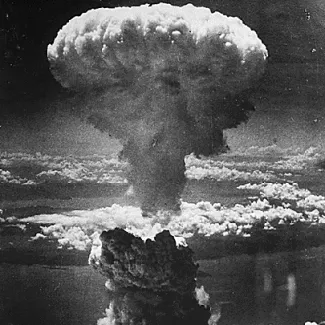
U.S. National Archives
Despite victory in Europe, war with Japan raged on. In March 1945, the United States firebombed Tokyo, flattening the city. Approximately one hundred thousand civilians were killed, and one million people were left homeless. Japan’s military leaders refused to surrender. To end the war, U.S. President Harry S. Truman was presented with two options: an invasion of Japan or the use of a new weapon. Seeking to avoid a long and costly military operation, Truman turned to the latter: the nuclear bomb. On August 6, 1945, the United States dropped the first of these singularly destructive weapons on the Japanese city of Hiroshima. The atomic bomb instantly killed an estimated 80,000 people, and left over 120,000 to deal with severe burns and radiation poisoning. When the Japanese did not immediately surrender, the United States dropped another bomb on Nagasaki three days later, killing seventy-four thousand people. On August 15, 1945, the Japanese unconditionally surrendered. World War II, the deadliest conflict in history, had ended.
